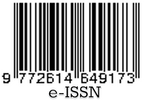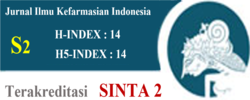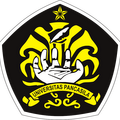The inhibition of α-Glucosidase enzyme activity from Standardised Ethanol Extract of Abelmoschus manihot (L.) Medik Leaves
Abstract
People have long utilised the leaves of the red gedi, Abelmoschus manihot (L.) Medik is an anti-diabetic medication. The study’s objectives were to classify chemical constituent groups, assess extract quality, and evaluate the activity of α-glucosidase enzyme inhibitors. The extraction method employed kinetic maceration with a 70% ethanol solvent, identification was accomplished through phytochemical screening, a quality determination was based on both specific and non-specific parameters, and α-glucosidase inhibition was used in an in vitro antidiabetic activity test. Flavonoids, alkaloids, saponins, steroids, and triterpenoids were found in the phytochemical screening test results. The results of the quality parameter test obtained viscous extract, blackish green color, 70.58% water soluble extract, 49.46% ethanol soluble extract, 7.82% loss on drying, 4.19% water content, total ash content 6.97%, acid insoluble ash content 0.60%, water-soluble ash content 5.64%, residual solvent 0.76%, heavy metal content Pb 1.35 mg/kg, Cd 0.06 mg/kg, plate number total ≤10 colonies/g, yeast plate number 20.1995 colonies/g and total flavonoid content 1.20%. The α-glucosidase enzyme inhibitory activity test from the extract and acarbose (positive controls) obtained IC50 values of 81.84 μg/mL and 42.6 μg/mL, respectively. In conclusion, the α-glucosidase enzyme may be inhibited by the ethanolic extract of A. manihot (L.) Medik leaves.
References
2. aroreh M, Rahardjo S, Hastuti P, Murdiati A. Antioxidant activities of sequentially extracted gedi’s (Abelmoschus manihot L) leaves. 2015;35(3):280-7.
3. Luan F, Wu Q, Yang Y, Lv H, Liu D, Gan Z, et al. Traditional uses, chemical constituents, biological properties, clinical settings, and toxicities of Abelmoschus manihot L.: A Comprehensive Review. Frontiers in Pharmacology. 2020;1;1-28.
4. Shamsudin NF, Ahmed QU, Mahmood S, Shah SAA, Sarian MN, Khattak MMAK, et al. Flavonoids as antidiabetic and anti-inflammatory agents: A Review on structural activity relationship-based studies and meta-analysis. International Journal of Molecular Sciences. 2022;23(20):12605.
5. Barung EN, Ulaen SP, Banne Y, Dumanauw JM, Maluenseng GS. Antidiabetic effect test of etyhyl acetate fraction ethanol extract of Abelmoschus manihot L medic leaves in Streptozotocin-induced rats (Rattusnorvegicus). Proceeding Manado Health Polytechnic 1st International Conference ISSN : 2599-203. 2017 ;1(1):428–33.
6. Joshi SR, Standl E, Tong N, Shah P, Kalra S, Rathod R. Therapeutic potential of α-glucosidase inhibitors in type 2 diabetes mellitus: an evidence-based review. Expert Opinion on Pharmacotherapy. 2015;16(13):1959–81.
7. Bhatia A, Singh B, Arora R, Arora S. In vitro evaluation of the α-glucosidase inhibitory potential of methanolic extracts of traditionally used antidiabetic plants. BMC Complementary and Alternative Medicine. 2019;19(1):1-9.
8. Van de Laar FA, Lucassen P, Akkermans RP, Van de Lisdonk EH, De Grauw WJC. Alpha‐glucosidase inhibitors for people with impaired glucose tolerance or impaired fasting blood glucose. Cochrane Database Syst Rev. 2006;(4):1-5.
9. Shulammithi, R., Sharanya, M., Tejaswini, R., & Kiranmai, M. Standardization and quality evaluation of herbal drugs. IOSR Journal of Pharmacy and Biological Sciences. 2016;11(5):89–100.
10. Directorate General of Pharmaceutical and Medical Devices Pharmacopoeias Formularies Herbal Medicine (II. ed.), Ministry of Health Republic Indonesia, Jakarta (2017).
11. Sahoo N, Manchikanti P. Herbal drug regulation and commercialization: an Indian industry perspective. The Journal of Alternative and Complementary Medicine. 2013;19(12):957–63.
12. Dey YN, Wanjari MM, Srivastava B, Kumar D, Sharma D, Sharma J, et al. Beneficial effect of standardized extracts of Amorphophallus paeoniifolius tuber and its active constituents on experimental constipation in rats. Heliyon. 2020;6(5):e04023.
13. Pratami DK, Mun’im A, Sundowo A, Sahlan M. Phytochemical profile and antioxidant activity of propolis ethanolic extract from Tetragonula bee. Pharmacog¬nosy Journal. 2018;10(1):128-35.
14. Assefa ST, Yang EY, Chae SY, Song M, Lee J, Cho MC, et al. Alpha glucosidase inhibitory activities of plants with focus on common vegetables. Plants. 2019;9(1):1-17.
15. Chumbhale DS, Khyade MS. Pharmacognostic evaluation and development of quality control parameters for root of Abelmoschus manihot (L.) medik. Pharmacognosy Research. 2023;15(1):101-11.
16. Todarwal A, Jain P, Bari S. Abelmoschus manihot Linn: ethnobotany, phytochemistry and pharmacology. Asian Journal of Traditional Medicines. 2011;6(1):1-7.
17. The Indonesian Food and Drug Authority, 2019. Indonesian FDA decree no 32 year 2019 about requirements for safety and quality of traditional medicines, The Indonesian Food and Drug Authority, Jakarta.
18. Dirir AM, Daou M, Yousef AF, Yousef LF. A review of α-glucosidase inhibitors from plants as potential candidates for the treatment of type-2 diabetes. Phytochemistry Reviews. 2022 Aug;21(4):1049-79.
19. Bergman ME, Davis B, Phillips MA. Medically useful plant terpenoids: biosynthesis, occurrence, and mechanism of action. Molecules. 2019;24(21):3961.

This work is licensed under a Creative Commons Attribution-NonCommercial-ShareAlike 4.0 International License.
Licencing
All articles in Jurnal Ilmu Kefarmasian Indonesia are an open-access article, distributed under the terms of the Creative Commons Attribution-NonCommercial-ShareAlike 4.0 International License which permits unrestricted non-commercial used, distribution and reproduction in any medium.
This licence applies to Author(s) and Public Reader means that the users mays :
- SHARE:
copy and redistribute the article in any medium or format - ADAPT:
remix, transform, and build upon the article (eg.: to produce a new research work and, possibly, a new publication) - ALIKE:
If you remix, transform, or build upon the article, you must distribute your contributions under the same license as the original. - NO ADDITIONAL RESTRICTIONS:
You may not apply legal terms or technological measures that legally restrict others from doing anything the license permits.
It does however mean that when you use it you must:
- ATTRIBUTION: You must give appropriate credit to both the Author(s) and the journal, provide a link to the license, and indicate if changes were made. You may do so in any reasonable manner, but not in any way that suggests the licensor endorses you or your use.
You may not:
- NONCOMMERCIAL: You may not use the article for commercial purposes.
This work is licensed under a Creative Commons Attribution-NonCommercial-ShareAlike 4.0 International License.





 Tools
Tools





















